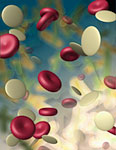Platelet rich plasma or PRP is derived from blood. The usual case is a patient wanting PRP therapy will have their own blood drawn and PRP will be extracted from this. This is called autologous blood (“from yourself’.) This has the great advantage that there is no risk of transmitting any infectious agent or having a graft rejection because the patient’s own blood is being used.
 Blood components have the powerful ability to heal injured tissues which can include muscle, tendon, ligaments and bone as well as many other structures in the body. The value of PRP is that it is the concentrated healing components of the blood which include platelets and “dense granules”, both of which contain bioactive proteins that initiate and sustain tissue healing and regeneration. Over the past 20 years FDA approved PRP therapy has been used in a wide variety of medical applications including orthopedics, cardiac surgery, dentistry, facial surgery, wound healing and sports medicine. PRP provides patients a safe alternative to surgery or repeated steroid injections.
Blood components have the powerful ability to heal injured tissues which can include muscle, tendon, ligaments and bone as well as many other structures in the body. The value of PRP is that it is the concentrated healing components of the blood which include platelets and “dense granules”, both of which contain bioactive proteins that initiate and sustain tissue healing and regeneration. Over the past 20 years FDA approved PRP therapy has been used in a wide variety of medical applications including orthopedics, cardiac surgery, dentistry, facial surgery, wound healing and sports medicine. PRP provides patients a safe alternative to surgery or repeated steroid injections.
The procedure involves drawing 60 cc (2 ounces) of blood from a patient’s arm. The blood is then put in a special centrifuge for processing. The platelets and other bioactive plasma protein cells (dense granules) separate out and are concentrated. The normal platelet count of 200,000-400,000 is concentrated to over 1 million platelets per microliter. This is the concentration necessary for PRP to be effective. Within the platelets are alpha granules. These contain several growth and clotting factors involved in the healing process. When activated these factors are released and the platelets clump together to form a graft over the area of injured tissue. The dense granules contain over 100 growth factors, all of which are released when the PRP is activated at the site of injection into the injured tissue. Within the blood serum are three proteins – fibrin, fibronectin and vitronectin – which in concentrated form create a protein matrix for tissue healing cells (fibrinocytes) to attach to and regenerate tissue.
Once injected into the injured tissue, PRP is activated with thrombin which causes the release of over 100 growth related bioactive proteins and cytokines. These chemical messengers attract white blood cells to remove injured tissue and prevent infection. Stem cells are recruited into the area to form new tissue. Osteoblasts move in to reform boney tissue. The fibrinocytes migrate in and lay down collagen on the protein matrix, all of which regenerates new, healthy, stronger tissue. This is in contrast to normal tendon or ligament healing, where there is a relative lack of vascular supply. The normal inflammatory response to allow for healing does not occur and these structures heal by forming scar tissue. Scar tissue is not as strong as normal or well healed tendon. Additional scarring can lead to limited range of motion and even pain. PRP avoids this problem by stimulating normal, healing inflammation, development of new blood vessels (angiogenesis) and orderly collagen deposition to form a stronger tendon or ligament. Using PRP is applying a bioactive treatment, low in risk, to heal the tissue in a biologically natural way (regenerative medicine). No other treatment alters the healing process in this natural, positive manner.
After preparing the PRP, the site to be injected is anesthetized with local anesthetic. The skin surface is prepped to create a sterile area for injection of PRP. The PRP is then injected to the tender area of tissue and “peppered” around the area to get the maximum application of the healing graft. Thrombin is then injected to activate the healing process. Patients usually experience mild pressure with mild to moderate discomfort. This is normal and is part of the initial inffamation response, which can last a week. Pain can be managed with Tylenol products and ice packs. Do not take any anti-inflammatory medications such as aspirin, ibuprofen or naproxen for the first 6 weeks after treatment. With using the patient’s own blood the risk of disease transfer or graft rejection is eliminated. There have not been any studies to show that PRP promotes tumor or cancer cell growth. Growth factors involved in healing do not cause cellular mutation but rather activate normal gene expression for normal wound healing. As with any injection therapy, there is a low risk of allergic reaction to anesthetic, infection, worsening of pain (temporarily), lack of symptom relief, nerve injury or scar tissue formation.
In summary, PRP is a new, innovative treatment method to initiate and promote the body’s own natural healing mechanism. The difference is, is that this healing power can be concentrated and applied to the area(s) of the body that are failing to respond to more traditional treatments. The procedure is very safe and can be done in an outpatient setting in about 60 minutes, without any “recovery time” afterward. Physical therapy can, in some cases, be helpful in shortening recovery time and improving function. Ask your doctor if PRP may be helpful for you. Contact Sarasota Neurology for a platelet rich plasma consultation.
